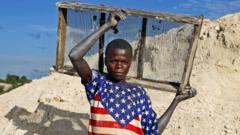The Chinese government has initiated a nationwide subsidy program aimed at combatting a demographic crisis linked to continuously falling birth rates, announcing financial support of 3,600 yuan (approximately $500) annually for each child under three years old.
China Launches 3,600 Yuan Annual Subsidy to Encourage Higher Birth Rates

China Launches 3,600 Yuan Annual Subsidy to Encourage Higher Birth Rates
In response to declining birth rates, China is now offering financial incentives to families with young children.
China's birth rate has been on a downward trajectory since the abolition of the one-child policy nearly a decade ago. As part of the new initiative, families can receive a total of up to 10,800 yuan per child, with the payment structure retroactively effective from January 2024, impacting roughly 20 million families, as reported by state-run media.
Various provinces have previously experimented with financial incentives to promote childbirth. For instance, Hohhot in northern China has provided up to 100,000 yuan for couples welcoming three or more children, while Shenyang has extended a monthly subsidy of 500 yuan to families with a third child.
Additionally, the authorities are encouraging local governments to devise plans for free preschool education, which would further alleviate the financial burdens associated with childcare.
A recent study conducted by the YuWa Population Research Institute indicates that raising a child in China until the age of 17 can cost an average of $75,700—higher than many might expect.
Official data have shown a concerning trend, with China recording a third consecutive year of population decline in 2024, marking only 9.54 million births, a slight increase from the previous year but insufficient to reverse the shrinking population trend. As China's population, currently around 1.4 billion, continues to age rapidly, these measures highlight the urgent need for action to address demographic challenges.
Various provinces have previously experimented with financial incentives to promote childbirth. For instance, Hohhot in northern China has provided up to 100,000 yuan for couples welcoming three or more children, while Shenyang has extended a monthly subsidy of 500 yuan to families with a third child.
Additionally, the authorities are encouraging local governments to devise plans for free preschool education, which would further alleviate the financial burdens associated with childcare.
A recent study conducted by the YuWa Population Research Institute indicates that raising a child in China until the age of 17 can cost an average of $75,700—higher than many might expect.
Official data have shown a concerning trend, with China recording a third consecutive year of population decline in 2024, marking only 9.54 million births, a slight increase from the previous year but insufficient to reverse the shrinking population trend. As China's population, currently around 1.4 billion, continues to age rapidly, these measures highlight the urgent need for action to address demographic challenges.





















